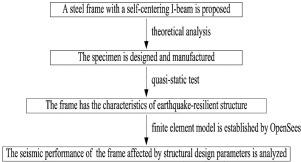当前位置:
X-MOL 学术
›
J. Constr. Steel Res.
›
论文详情
Our official English website, www.x-mol.net, welcomes your feedback! (Note: you will need to create a separate account there.)
Seismic performance of steel frame with a self-centering beam
Journal of Constructional Steel Research ( IF 4.1 ) Pub Date : 2020-12-01 , DOI: 10.1016/j.jcsr.2020.106349 Pei-Wen Shen , Pu Yang , Ji-Hao Hong , Yi-Ming Yang , Xiao-Yi Tuo
Journal of Constructional Steel Research ( IF 4.1 ) Pub Date : 2020-12-01 , DOI: 10.1016/j.jcsr.2020.106349 Pei-Wen Shen , Pu Yang , Ji-Hao Hong , Yi-Ming Yang , Xiao-Yi Tuo

|
Abstract Self-centering moment-resisting frames are capable of returning to their original plumb position after a severe earthquake, having sustained no or only slight structural damage. In this paper, a steel frame composed of a self-centering I-beam is proposed, with its capacities for self-centering and inelastic deformation provided by post-tensioned (PT) strands and energy dissipating (ED) elements, respectively. Based on an analysis of its mechanical properties, an experiment involving this self-centering frame under cyclic loading was conducted to investigate its load transfer mechanism, bearing capacity, hysteretic behaviour, ductility, energy dissipating capacity and self-centering capacity. The results agree well with the theoretical analysis, and it can be concluded that its force-displacement hysteretic curve has a typical flag shape. The plastic deformation of the specimen is concentrated on the ED elements, which can be replaced easily after an earthquake. As the gap-opening of the anchorage plate occurs, the PT strands and ED elements provide the bending stiffness for the structure. When the story drift is loaded to 4%, the skeleton curve does not have a descending section, which means that the structure still has sufficient bearing and deformation capacities. The analysis of the residual story drift and the equivalent viscous damping coefficient shows that the frame has good energy dissipating and self-centering capabilities. A finite element model is established with OpenSees to simulate the seismic behaviour of the self-centering frame. Using the model, the seismic performance of the frame is analysed in terms of its structural parameters, including the section area of the PT strands, initial stress on the PT strands and section area of the ED elements.
中文翻译:

自定心梁钢框架的抗震性能
摘要 自定心抗弯框架在发生大地震后能够恢复到原来的铅垂位置,没有或只有轻微的结构损坏。在本文中,提出了一种由自定心工字梁组成的钢框架,其自定心和非弹性变形能力分别由后张 (PT) 钢绞线和耗能 (ED) 元件提供。在分析其力学性能的基础上,对该自定心框架在循环载荷下进行了实验,研究了其载荷传递机制、承载能力、滞回行为、延展性、能量耗散能力和自定心能力。结果与理论分析吻合较好,可以得出其力-位移滞后曲线具有典型的旗形。试件的塑性变形集中在 ED 元件上,在地震后可以很容易地更换。随着锚固板的间隙开口发生,PT 钢绞线和 ED 元件为结构提供抗弯刚度。当楼层位移加载到4%时,骨架曲线没有下降段,这意味着结构仍然具有足够的承载和变形能力。对剩余层间位移和等效粘滞阻尼系数的分析表明,该框架具有良好的耗能和自定心能力。利用OpenSees建立有限元模型来模拟自定心框架的抗震性能。使用该模型,根据框架的结构参数分析框架的抗震性能,
更新日期:2020-12-01
中文翻译:

自定心梁钢框架的抗震性能
摘要 自定心抗弯框架在发生大地震后能够恢复到原来的铅垂位置,没有或只有轻微的结构损坏。在本文中,提出了一种由自定心工字梁组成的钢框架,其自定心和非弹性变形能力分别由后张 (PT) 钢绞线和耗能 (ED) 元件提供。在分析其力学性能的基础上,对该自定心框架在循环载荷下进行了实验,研究了其载荷传递机制、承载能力、滞回行为、延展性、能量耗散能力和自定心能力。结果与理论分析吻合较好,可以得出其力-位移滞后曲线具有典型的旗形。试件的塑性变形集中在 ED 元件上,在地震后可以很容易地更换。随着锚固板的间隙开口发生,PT 钢绞线和 ED 元件为结构提供抗弯刚度。当楼层位移加载到4%时,骨架曲线没有下降段,这意味着结构仍然具有足够的承载和变形能力。对剩余层间位移和等效粘滞阻尼系数的分析表明,该框架具有良好的耗能和自定心能力。利用OpenSees建立有限元模型来模拟自定心框架的抗震性能。使用该模型,根据框架的结构参数分析框架的抗震性能,



























 京公网安备 11010802027423号
京公网安备 11010802027423号